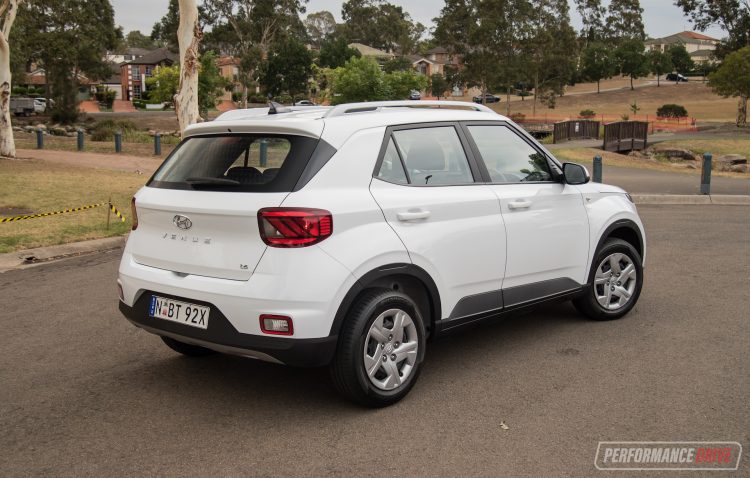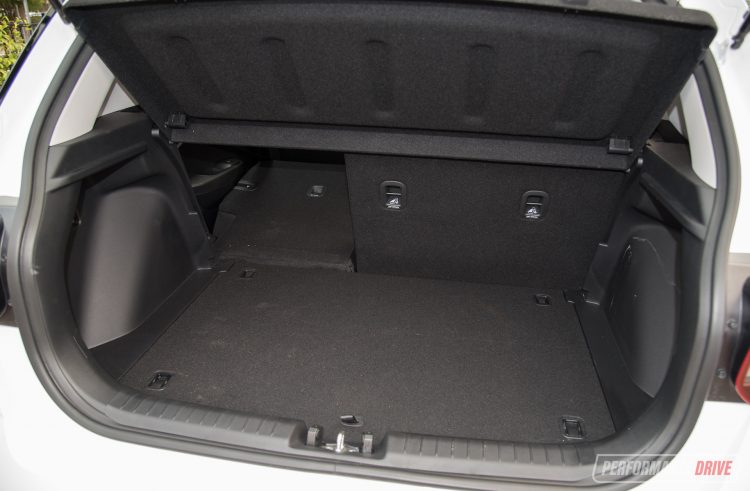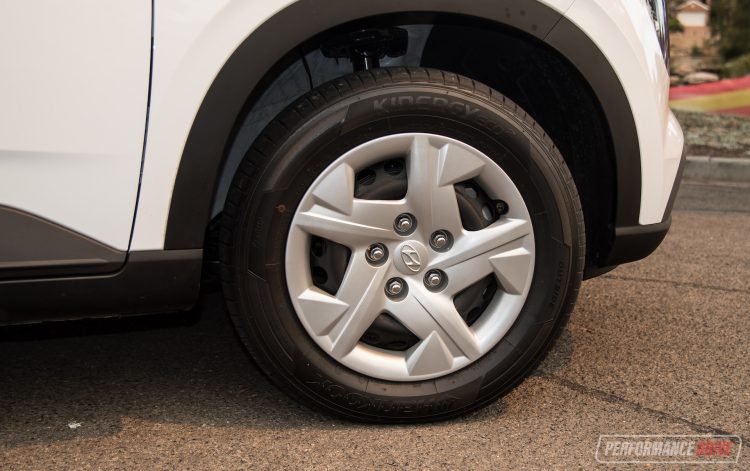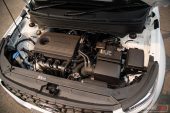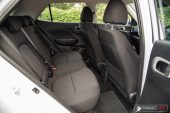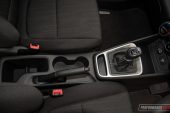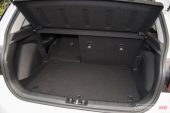Just when you thought the market was flooded with enough SUVs, Hyundai goes ahead and releases a brand-new model; the Venue. Going by SUV sales numbers in recent years, it seems the market could never have enough models. This time, the Venue slots itself in as the smallest of now four SUVs in the company’s showroom.
Buyers can choose from the entry-level Go, the mid-range Active, or the range-topping Elite. There is also a ‘Launch Edition’ available for a limited time. You can opt for a six-speed manual or six-speed auto in the lower two variants, but the top spec comes with the auto only. We’re giving the entry level Go… a go, in manual form.
All models in Australia are front-wheel drive and come fitted with a 1.6-litre petrol engine that produces 90kW and 151Nm – other markets are offered a 1.2L (61kW/115Nm) and even a 1.0L turbo (88kW/172Nm), but the 1.6 that we get is the most powerful of the lot. Prices begin at a thrifty $19,990 for the manual Go, and peak at $25,990 for the Launch Edition (plus on-road costs)
2020 Hyundai Venue Go – THE SPECS
[column width=”47%” padding=”6%”]Engine: 1.6-litre four-cylinder
Output: 90kW@6300rpm / 151Nm@4850rpm
Transmission: Six-speed manual
Drive type: Front-wheel drive
Wheels: F & R: 15×6.0 steel, 185/65
ANCAP: Four stars
Tare weight: 1174kg
Power-to-weight: 13.0:1 (kg:kW)
Official fuel economy: 7.0L/100km
Economy during test: 7.4L/100km
Fuel capacity/Type: 45L/91 RON[/column] [column width=”47%” padding=”0″]Power efficiency: 12.85kW:L/100km
0-60km/h: 4.63 seconds*
0-100km/h: 10.19 seconds*
60-110km/h: 7.85 seconds*
1/4 mile: 17.82 seconds at 130.8km/h*
Max acceleration: 0.605g
100-0km/h braking: 3.03 seconds at 38.98 metres*
Max deceleration: -1.199g
Decibel at idle: 38*
Peak decibel at 60-100km/h: 80*
Priced from: $19,990[/column][end_columns]
* Figures as tested by PerformanceDrive on the day. Factory claims may be different
2020 Hyundai Venue Go – THE PACKAGE
The Venue is based on the Accent platform, which is getting pretty old now, but this car adopts a fresh design dissimilar to any other model in Hyundai’s current range. And yes, we called it a car – we’re reluctant to call it an SUV. It has a tall roofline and steeply sloped rear that is almost van-like. We love the funky small taillights and inward swoop on the tailgate, which makes it look fun and modern. There are some vibrant paint colours and colour combinations to choose from too.
Turning to the inside, the space is surprisingly roomy for the small SUV market. The high roofline and uncluttered design are excellent in maximising storage room and providing an airy feel. It reminds us of the practicality and headroom of the Honda Jazz in some ways.
And being higher off the ground means it is easy-peasy to step in and out of. Whether you’re in the front or rear row, there’s an abundance of legroom to for a small SUV too. Though, the seats lack bolstering support and adjustment in the Go. So, you might become more fatigued on longer trips.
The interior layout is fantastically straightforward but in a reasonably modern (modern enough) way. Buttons and dials feel good in quality in most areas, considering the Venue’s cheap price. There are some hard plastics used, but they still make the interior look strong and practical. Hyundai has been thoughtful to provide plenty of storage bins and cupholders to help you feel at home. There’s a space in front of the gearstick, and a generously-sized centre console and door pockets.
Since rear seat legroom is reasonable, boot volume isn’t huge; but it’s a tall and more usable space than the Mazda CX-3, for example. It officially measures in at 355 litres, which is much bigger than the latest Toyota Corolla and Mazda3 (295L) hatches.
All Venue models are well-equipped with forward collision warning with pedestrian detection, active lane-keeping assist and departure warning, driver attention detection, a rear-view camera, auto high-beam, and tyre pressure sensors. However, ANCAP has only awarded the Venue a four-star ANCAP safety rating, which is something to consider.
You also get an 8.0-inch touch-screen media interface, with Android Auto and Apple CarPlay, Bluetooth, and a four-speaker stereo (that sounds weak and distorts easily), all as standard. The Go misses out on alloy wheels (the 15-inch steel wheels look a little silly), adaptive cruise control, rain-sensing wipers, proximity remote locking, and parking sensors.
2020 Hyundai Venue Go – THE DRIVE
All Venues are fitted with the same humble 1.6-litre naturally aspirated four-cylinder petrol engine. It won’t give you any thrills, but it does the job of buzzing around the city competently. Some of the competition use turbochargers for their offerings – even at this level – to give a bit more kick during mid-range pick up and torque for the hills. And the Venue could do with one; at least for the more deluxe models. Maybe later in its model lifecycle?
Going up hills will cause you to become thrashy with the engine, but a regular take-off on the flat is not such a breathless task. The full 90kW doesn’t come into play until a high 6300rpm, and the 151Nm of torque could do with the boost of a turbo to bring it in earlier than the current 4850rpm peak.
The manual transmission gives the Venue a fun, zippy and more interactive vibe. Gear shifting is smooth, and the gear ratios seem to match well to get things moving. Official figures rate 0-100km/h acceleration at 11.4 seconds with the auto. Our testing revealed 10.19 seconds with the manual, which is not too shabby at all for this class.
In terms of driving dynamics, the Venue isn’t as sturdy as the Kona which competes in the same class. A basic rear suspension layout and relatively long-travel suspension overall means tackling corners hard is accompanied by some body roll. Expect a decent amount of feedback and steering weight returned to you though.
It can be quite enjoyable purely because you can toss the weight around, of which there is only 1174kg. Of course, downhill is better. Those narrow 15-inch steel wheels are the first to give way, wrapped in eco-focused Hankook 205/55 tyres. In saying all of this, the Venue is great in the city, and actually more fun. The Aussie-tuned suspension provides plenty of absorption on old, bashed-up city roads. And speed bumps and high entrances to car parks are not an issue.
Although our testing will be harsher than most customer scenarios, we achieved a fuel consumption average of 7.4L/100km. It’s official rating of 7L/100km is slightly above average for a small, two-wheel drive petrol of similar output. With no turbo, you’re inclined to put your foot down more, which won’t help the fuel consumption figures. At least it is compatible with the cheapest fuel on the market (E10). The fuel tank only holds 45 litres, so refuels might be more frequent than you’re used to – we found we could stretch to about 600km between refuels.
2020 Hyundai Venue Go – THE VIDEO
2020 Hyundai Venue Go – THE VERDICT
The Venue covers many market demands; it is surprisingly roomy inside, very well equipped and packaged, it’s light and fun to drive and perfect for zipping around the city, it’s stylish and modern, and it has extra ground clearance to feel like an SUV. The only gripes we have are the 15-inch steel rims on the Go, and the fact there are no sportier engines or all-wheel drive options available. If this doesn’t bother you, as well as the four-star ANCAP rating, then the Venue is certainly worth checking out.
[column width=”47%” padding=”6%”]PROS:
– Cheap entry price
– Spacious and practical interior for its segment
– Fresh and fun exterior design
– Easy to drive
– Well equipped for base model; standard touchscreen, Apple CarPlay etc.[/column] [column width=”47%” padding=”0″]CONS:
– 15-inch steel rims on the Go look cartoonishly small
– 4-speaker stereo sounds terrible when you crank up the volume
– 4-star ANCAP safety rating[/column][end_columns]
As always, if you’re thinking about buying a new car don’t forget to click here to speak with our car buying specialists.

